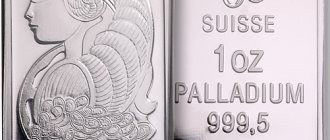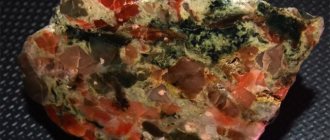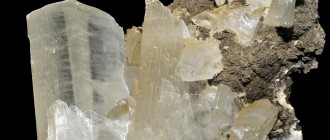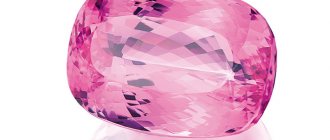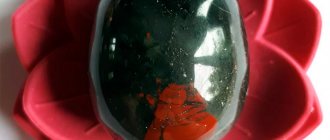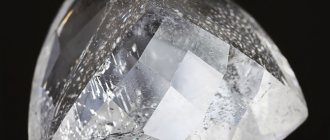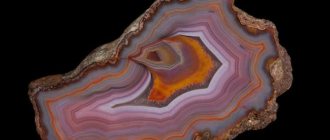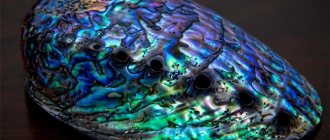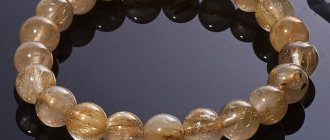The mineral sphalerite is a zinc sulfide, and a major source of zinc metal mining due to its high abundance. It is often called “zinc blende”, since the stone contains an accompanying admixture of iron, which, with different contents, significantly affects its appearance. For this reason, sphalerites are often confused with other minerals, such as galenas. And because of the wide range of colors characteristic of the stone, it also received many names, including pseudogalenas, “honey blende”, “ruby blende”, marmarites, cleiophanes and others. All these minerals are essentially subspecies with different colors and accompanying metals in their composition.
Chemical composition
Chemical theoretical composition: Zn - 67.06; S - 32.94. Usually the mineral contains an isomorphic admixture of Fe (the maximum Fe content is about 26%); less commonly, Zn is replaced by Mn (up to 5.81%). Almost always contains some amount of Cd, usually less than 0.8%, maximum 2.47% (“prshibramite”). It is also quite common to contain small amounts of Ga, Ge - up to thousandths of a percent, In - up to 0.01%; The content of Hg in sphalerite was 1% (Oberzeiring, Austria), Ti - up to 1% (“shell blende” from Raibl, Italy). It often contains Au, Ag, Sn, Pb, Ni, and, apparently, also Co, Bi, Sb, which, however, is partly due to the presence of mechanical impurities. The content of trace elements varies in accordance with the conditions of formation, the composition and nature of the geochemical province. In general, colloform and shell-like sphalerites contain more trace elements. Mn is typical for higher-temperature sphalerites, Cd for medium-temperature ones, and Ge for medium- and low-temperature sphalerites. Ga and Ge are most often contained in sphalerites of sulfide deposits, while sphalerites of contact deposits are poorer in trace elements. The indication by Goldschmidt and Peters about the relationship between the Ga and As contents in sphalerites is not confirmed. The presence of Ge in shelled sphalerites is accepted as an indication that ZnS was initially precipitated as wurtzite. In is typical for sphalerites of high-temperature tin and tin-lead-zinc deposits; Ti is also noted in sphalerites of tin ore deposits.
Varieties
1) By composition:
- Cleiophane - cleiophane (Henry, 1851) - light-colored or colorless, almost without Fe and Mn impurities (cramerite Henry, 1851).
- Marmatite - marmatite (Bussigneau, 1829) - black, rich in iron (Shepard's marasmolit, 1851; Piddington's newboldite, 1847; Breithaupt's Christophite, 1863).
- Prshibramite (pshibramite, pribramite) [Huot, 1841] - enriched with cadmium.
2) By type of discharge:
Cleiophanes
- ordinary crystalline;
- colloform shell-like zincblende , sometimes a mixture of sphalerite and wurtzite;
- brunkite —brunckite — earthy or collomorphic, finely crystalline, almost white (Hertsenberg, 1938);
- gumucionite - gumucionite (Hertsenberg, 1933). Nodular; crimson, dirty pinkish-red, partly brownish.
Hardness greater than 4. Density. 3.76. The line is light yellow. Isotropic. Chemical composition: Zn - 64.73; Cd - traces; S - 32.75; As - 0.64; Fe - 0.27 (due to pyrite inclusions); H2O - 1.28; n. O. — 0.52 (quartz + cassiterite); amount - 100.19. It dissolves easily in HCl, releasing H2S and flocculated sulfide. On coal it produces a coating of As2O3 with a CdO rim. Found at a depth of 320 m in the Lllalgua tin deposit in Bolivia with quartz, cassiterite, pyrite, etc. Not studied by X-ray methods; Possibly an arsenic-bearing colloform sphalerite.
What is a stone
The origin of the mineral is twofold: it is formed among sedimentary igneous rocks or hydrothermal vents.
These are grainy translucent, translucent, transparent crystals that shine like diamonds. Or opaque dull ones.
The description of the stone always includes an indication of color. In pure crystals it is white; impurities create brown, brown, and black shades. Colorless, yellowish, purple-orange, and green specimens are considered rare.
The structure of sphalerite is almost the same as that of diamond.
Form of being in nature
The appearance of crystals. Crystals are predominantly tetrahedral or cuboctahedral, less often dodecahedral. Negative octants are usually richer in forms than positive ones.
Twins for sphalerite are very common : intergrowth, intergrowth and complex twins. Twin axis [111], twin plane most often (112). The mineral forms oriented intergrowths with chalcopyrite, tetrahedrite, stannite, also with millerite, pyrrhotite; often contains liquid and gas inclusions.
Aggregates.
Granular, in the form of phenocrysts, often in crystals; also shell-like, kidney-shaped and cryptocrystalline secretions (concretions and oolites), sometimes collomorphic; rarely earthy (brunkite).
The first explorers
The deceptive mineral was first explored and described in the book “De natura fossilum” by the famous German metallurgist and ore explorer Georg Agricola (1546). Then, during the Renaissance, there were no scientific classifications or generally accepted names (except magical ones) for many minerals and semi-precious stones. In his work, Agricola calls the stone according to the tradition of German miners: B lende - blende .
The modern name - Sphalerite - was introduced by the German scientist Ernst Glocker in the mid-19th century. In Greek this word means treacherous, treacherous, deceptive.
Physical properties
Optical
Black sphalerite crystals
- The color is very diverse, often varying within one piece; usually brown, as well as black (with a high Fe content), less often - reddish, yellow, green, colorless (in the absence of Fe), white and grayish (brunkite).
- The character of the mineral varies according to its composition: colorless, light-colored (yellow and brown tones); in Fe-rich varieties it is brown and brown, in bruncite it is light cream.
- shine ,
- The tint is greasy, while bruncite has a matte finish.
- Transparency Transparent or semi-transparent (usually transparent up to 5% Fe).
Mechanical
- Hardness 3.5-4. fragile
- Density 3.9-4.1; in general, density decreases as the content of Fe and gas and liquid inclusions increases.
- Cleavage (110 each) is perfect (due to the location of both Zn and S atoms in this plane). In six directions parallel to the faces of the rhombic dodecahedron (regular dodecahedron).
- The fracture is conchoidal.
Chemical properties
Dissolves in concentrated HNO3 with the release of S, in HCl with the release of H2S. Cryptocrystalline brunkite dissolves in HCl more easily than clear-crystalline sphalerite, sometimes even with boiling; It is also difficult to dissolve in acetic acid.
In polished sections, HNO turns slightly brown, other reagents have no effect. The structure is revealed in aqua regia vapor or by etching KMnO4 + H2SO4.
Other properties
Brunkite sticks to the tongue, when it comes into contact with water, it absorbs over 10% of the water and turns gray. Poor conductor of electricity. Dielectric constant 7.9. It has piezoelectric and pyroelectric properties, partially photoelectric conductivity. When irradiated by α-particles, pulsed conductivity is excited. Diamagnetic in the absence of Fe or its content up to 0.4%; more ferrous varieties are paramagnetic.
Natural sphalerites exhibit blue, yellow, orange and reddish luminescence in ultraviolet rays. Blue luminescence is caused by the presence of minute amounts of Ag, which is confirmed by experiments on the artificial production of ZnS with Ag additives. Yellow and orange luminescence appears when sphalerite contains about 0.01% Mn. The reddish luminescence may be due to the presence of trace amounts of Fe.
Sometimes sphalerite glows when split, rubbed or scratched (triboluminescence).
Behavior of a mineral when heated The refractive index in the visible part of the spectrum increases significantly with increasing temperature. At 880-1020° it transforms into wurtzite (α-ZnS), and the transition temperature decreases as the content of Fe, Mn, and Cd increases. The heat of transformation of sphalerite into wurtzite is 3190 cal/mol. Within the range of 600-1200° it transforms into the trigonal modification - γ -ZnS. Sublimates until melted.
Scope of use
Sphalerite has a high industrial purpose. Many specimens are of interest to mineral collectors. The stone also finds use among lithotherapists and magicians, however, it is poorly represented in jewelry.
Zodiac compatibility
Astrologers do not assess who the gem is suitable for, what signs and how it should be worn.
But astrologers note that it is better for Scorpios to avoid the stone; they will often get into unpleasant incidents with it.
For other elements the gem is neutral.
Medicinal properties
Lithotherapists recommend wearing jewelry with sphalerite for people suffering from skin diseases (eczema, dermatitis, etc.). The gem helps alleviate the course of the disease. The stone also helps fight neurological problems (insomnia, stress, aggression). All light-colored specimens are suitable for this. Also, stones of such shades can improve vision.
Dark crystals protect against colds and flu, and also help improve the body’s readings if the disease has already occurred; the mineral has an antiseptic and anti-inflammatory effect.
Magic properties
The aura of black stones is often used by magicians in rituals. With their help, sorcerers can cause damage, a curse, and also call upon representatives of the other world. However, the stone necessarily returns all the negative effects to the source, doubling the effect, so you should think before using sphalerite for negative purposes.
White and yellow varieties are used to create protective amulets. They protect the owner’s home, and also create an impenetrable shell from the evil eye for the owner and his loved ones. In addition, such stones bring peace, tranquility, relieve anger, and set one in a positive mood.
Jewelry
Due to its fragility and perfect cleavage, as well as its low price, the gem is almost never used by jewelers to create jewelry. When cutting, it is easy to split or crumble.
Absolutely transparent crystals from Spain and Mexico, yellow, red and orange, are sometimes shaped into cabochons or other options with a small number of facets. Such jewelry inserts are quite soft and can be easily damaged, but they shimmer beautifully like a diamond. Astrologers do not give recommendations on which hand to wear a piece with a gem on or what stones to combine it with.
Industrial significance
The stone is used industrially to produce zinc (up to 95% of this metal is mined from sphalerite). It is also a source of rare elements such as cadmium, indium, and gallium.
Zinc is used to create alloys of brass, aluminum, and bronze. The metal is needed in the production of radio electronics, car tires, and the chemical industry. In construction, the constituent elements of stone are used to produce galvanized iron for roofs, power line supports, and engineering structures (for example, highway fences). Surfaces impregnated with zinc chloride do not rot, so it is used with railway sleepers, wooden bridges, and poles.
The gem is a source for creating phosphors that can emit light. This property is used in LCD screens, signaling equipment, instrumentation, lighting, markings and signs on highways. Also, the material obtained from the mineral is a semiconductor, which allows it to be used in lasers, optoelectronics, and LED screens. Previously, zinc was used in the creation of picture tubes. It also finds application in painting and paint production (zinc white, fluorescent paints).
Cadmium obtained from sphalerite is used to create coatings that prevent metal corrosion, the production of fire-fighting apparatus, as well as the production of alloys that are easy to melt, but strong and resistant to temperature influences. Gallium is used to fill precision instruments and produce “sunlight” lamps. Indium is used as an anti-corrosion element, as well as in the production of headlights and spotlights.
Artificial production of mineral
Obtained in various ways: by heating ZnS with an H2S solution in a sealed tube (Senarmont), in the form of small tetrahedra by heating natural sphalerite powder with a Na2S solution (Dölter), by the action of H2S on a ZnSO4 solution at high pressure and temperature (Allen, Crinshaw, Merwin); by passing H2S at temperatures below 870° over Zn metal powder. Unlike wurtzite, which precipitates from acidic solutions, sphalerite forms in slightly acidic and alkaline solutions.
Sphalerite with quartz and calcite. Klichka deposit
Diagnostic signs
Recognized by its perfect cleavage, strong diamond shine, and brown streak.
Marmatite has a reddish-brown streak. Dark ferruginous varieties differ from wolframite and enargite by the presence of cleavage in several directions; in addition, the density of wolframite is approximately twice the density of sphalerite. In polished sections, sphalerite differs from similar wurtzite by the presence of polysynthetic twins, from greenockite by the absence of lemon-yellow internal reflections, from magnetite by the presence of internal reflections, lower relief, and etching with aqua regia; Wolframite, similar to sphalerite, is characterized by sharp anisotropy.
Satellites Galena, arsenopyrite, pyrrhotite, chalcopyrite, pyrite, cubanite, magnetite, cassiterite, axinite, garnet, tourmaline, boulangerite, jamesonite, fahlores, bornite, from vein minerals - with quartz, calcite or barite.
Interesting facts about sphalerite
- Talismans and amulets with sphalerite are recommended for people who lack self-confidence in order to develop leadership qualities, fortitude, and achieve success. An untreated stone of any shade except black is suitable for this. An amulet made of transparent yellow stone will protect the owner from slander, envy, the evil eye, reduce irritability, anger and rage, and become a source of harmony and peace. In addition, such a talisman will prevent nightmares and insomnia.
- The effect of high temperatures on sphalerite depends on how much iron the sample contains. If there is a lot of iron, the stone will melt very easily, but pure mineral is resistant even to the effects of a blowpipe. The purity of sphalerite is also indicated by the color of the residue in the reduction flame: if the sample contains cadmium, then a brown-red coating is visible on it, while on a pure sample it is white.
Origin and location
The bulk of the deposits, as well as the galena with which it is almost constantly associated, belong to hydrothermal deposits. In some sulfide deposits it is associated with chalcopyrite.
Widely distributed in metasomatic deposits and ore veins.
It is formed extremely rarely under exogenous conditions. It was found in some coal deposits. During oxidation processes, sphalerite decomposes relatively quickly with the formation of zinc sulfite, which is easily soluble in water, as a result of which the oxidation zones are greatly depleted in zinc. If the side rocks of the deposit are represented by limestones, then accumulations of zinc carbonate - smithsonite - are formed in them. Sphalerite in lead-zinc deposits, as a rule, significantly predominates quantitatively over galena.
Mineral Change
During oxidation processes, the constituent parts of sphalerite are often removed in the form of relatively easily soluble zinc sulfate. Moreover, when located near limestones, sometimes very large accumulations of smithsonite are formed. Under the influence of solutions of sulfate and copper, sphalerite is easily replaced by a blue-black sooty mass of covellite, less often by chalcocite or bornite. As a result of oxidation due to sphalerite, smithsonite, monheimite, calamine, hydrozincite, aurichalcite, soconite, and sometimes limonite and other minerals appear.
How to distinguish from a fake
The cost of ornamental sphalerite is low, so it is of little interest to craftsmen who make fake stones. When purchasing it, you should still ask the seller for a mineral quality certificate and pay attention to the cost.
Jewelry-quality samples of sphalerite, although they have a high price, are very rare. Jewelry with them cannot be found at stone fairs; they are usually sold in single copies and in trusted salons. A distinctive feature of sphalerite from synthetic analogues in such cases is its high fragility - even a slight mechanical impact leaves a mark on the surface of the stone.
Place of Birth
Sphalerite crystals
The main development and industrial significance of sphalerite is in lead-zinc hydrothermal deposits in paragenesis with galena, partly with chalcopyrite, fahlores, bornite, from vein minerals - with quartz, calcite or barite (in Russia - deposits of Rudny Altai, Transbaikalia, Caucasus , and etc.).
Sphalerite is also widely developed in pyrite deposits, where it is accompanied by chalcopyrite, pyrite, etc. (pyrite deposits of the Sverdlovsk region).
It is partially released in the form of gels, giving characteristic oolitic and colloform formations with a spherulite structure or powdery aggregates (brunkite) (in the Truskavets deposit in Ukraine and in deposits in Poland). The so-called "shell zincblende" of some low-temperature deposits is usually a mixture of sphalerite and wurtzite; as a rule, the latter is largely replaced by sphalerite. Colloform ores are characterized by later precipitation of sphalerite compared to galena.
Apparently, sphalerite can sometimes form during the diagenesis of sedimentary rocks enriched in sulfur compounds - Borovichi district of the Novgorod region, Devonian deposits of Bashkiria (Russia), siderite accumulations of Devonian deposits, phosphorite nodules of the Silurian Podolia (Ukraine).
Supergene sphalerite is sometimes also observed in the form of deposits on wooden supports of abandoned mines, where, apparently, it was released in a reducing environment as a result of the interaction of zinc-containing solutions with organic matter.
In some deposits, druses of well-formed sphalerite crystals with calcite, quartz and other minerals are found, for example, in the Dalnegorsk deposit (Primorye); in the deposits of the Nagolny Ridge (Ukraine) and in Madan (Rhodope, Bulgaria). In a number of locations, very interesting colloform formations of sphalerite were encountered in the form of concentrically banded kidney-shaped segregations in voids among limestones in association with galena, pyrite, marcasite, chalcopyrite, calcite or dolomite.
In close association with chalcopyrite (almost without galena) it is observed in a number of so-called pyrite deposits of the Urals: the Karpushinskoye deposit, named after. III International, etc.
Of the most interesting foreign deposits from a mineralogical point of view, we note the following: Příbram (Czech Republic); beautiful crystals in voids among dolomite in Binnenthal (Switzerland), sphalerite crystals of remarkable transparency from deposits in the Santander region (Northern Spain).
Varieties
The following types of sphalerite are distinguished:
- Brunkit. Translucent white or yellowish stone. Object of hunting for collectors.
- Humuchionite. Kidney-shaped translucent crimson or pink stone. The arsenic sulfide in the composition makes it poisonous.
- Cleiophanes. Transparent amber-yellow, greenish-olive crystals. Because of its color, the stone is known as honeyblende.
- Senile. Ferrous, fragile. Looks cracked and out of shape.
- Marmatite. Iron-rich, opaque, matte black formations. The name is given from the place of the first discovery - the Marmato River in Peru.
- He'll be sad. Named after the French scientist Jean Proust. It looks almost like a ruby, which is why it is called ruby blende.
- Příbramit. The difficult-to-pronounce name comes from the name of the city of Příbram (Czech Republic), where the stone was first discovered. These are yellowish translucent crystals saturated with cadmium.
Sometimes classification by color is used.
Sphalerite on quartz
Crystal optical properties in thin preparations (sections)
In thin sections in transmitted light, sphalerite is isotropic, n = 2.36–2.47; with increasing Fe content, the refractive index increases: for varieties poor in iron, n is 2.369, with FeS 7-8% it is 2.39-2.40.
In reflected light it is gray, sometimes with a slightly bluish tint. Reflectivity. (in%): for green rays 18.5, for orange - 18.5, for red - 18. Isotropic. The color and density of internal reflexes change from colorless to thick brown; greenish and reddish internal reflexes are less common.
Many crystals are characterized by a zonal structure, which is revealed by etching in polished sections, and sometimes also by differences in luminescence. Polysynthetic twins are not uncommon, especially noticeable in polished sections after etching. Emulsion dissemination of chalcopyrite, cubanite, pyrrhotite or stannine, which are products of the decomposition of solid solutions, is often observed. In fine-grained aggregates it is polished well, in coarse-grained aggregates it is sometimes poorly polished (due to spalling along the cleavage).
Magic action
The stone in this area has been little studied, all that is known is that it is not used for rituals aimed at negativity and evil, because it contains the power of returning negative energy (especially in black specimens).
Magicians try not to use it because they risk harming themselves. More often, mineral crystals are used as amulets and amulets. There is an opinion that even a small fragment can protect against evil influence. Transparent or light yellow pieces of this breed are suitable for shy, repressed and insecure people. In them, it is able to develop leadership qualities, confidence, and helps increase self-esteem. Such amulets stones will help calm hot-tempered people, curb attacks of anger, and make it possible to find a sense of peace and mental balance.
It must be remembered that black zinc blende stones cannot be worn as amulets and amulets.
The stone in this area has been little studied, all that is known is that it is not used for rituals aimed at negativity and evil, because it contains the power of returning negative energy
